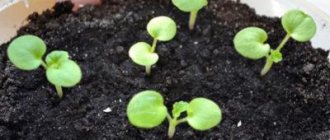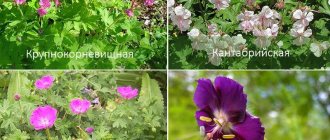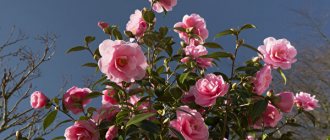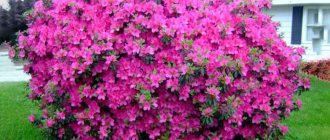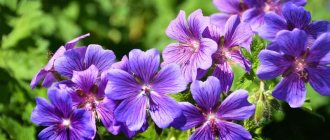Daisies are beautiful, romantic flowers that are often preferred by gardeners to decorate their garden landscapes.
Large garden daisies are easy to grow, they do not require special care and are perennial plants - which is not an ideal option for decorating your favorite garden. But before you grow a herbaceous plant, it doesn’t hurt to familiarize yourself with the basic conditions for growing healthy and flowering daisies.
Description of garden perennial chamomile
The brightest large-flowered plants are used to decorate flower beds.
Flower growers first became interested in daisies more than two hundred years ago, so many cultivated varieties have appeared over the years. And although perennial garden daisies can be of different heights, have different flowering times and inflorescence shapes, all daisies have much in common. First of all, this is a recognizable form of an inflorescence-basket, the core of which consists of small tubular yellow flowers, and the frame is made of false-ligulate petals.
Today, thanks to the efforts of breeders, semi- and double varieties of garden chamomile are available to gardeners.
Compared to wild specimens in cultivated perennials:
- flowers are larger;
- bud formation is much more active;
- the flowering period is longer;
- flowers may reappear in the second half of summer.
In early spring, a rosette of oblong basal leaves appears above the soil. When inflorescences appear on faceted, erect stems, the height of the plant can vary from 20 to 80 cm. Depending on the variety, the diameter of the inflorescences can reach from 3 to 10 cm.
Description of the flower
Chamomile feverfew has the following description:
- the stem is straight, from 50 to 70 cm high, but there are also dwarf species whose height does not exceed 10 cm;
- the leaves are pinnately shaped with dissections, the size of the leaf plates at the base of the stem is large, gradually decreasing towards its edge, the color of the foliage is bright green;
- inflorescences - baskets of tubular and reed flowers, diameter 3-6 cm;
- The color of the reed flowers is pink, the core is a rich yellow hue, there are varieties with white and crimson petals.
Pink perennial daisies are grown by gardeners. In the wild, where they reproduce by self-seeding, their life cycle is no more than 6 years.
The Persian species is characterized by long flowering, which lasts from the first days of June until the end of September.
Growing chamomile from seeds
Sowing chamomile
Growing chamomile is possible in seedlings and without seedlings. You can sow garden chamomile seeds simply in the ground, but it is safer to use the seedling method.
Chamomile seeds are sown for seedlings in March. Trays with cells are filled with a moist, light, breathable substrate consisting of peat and sand in equal parts, 2-3 seeds are placed in each cell, sprinkled with a thin layer of substrate on top, the container is covered with a transparent film and placed close to the window, but not on window sill, since the light passing through the glass is too intense and can damage the seed germination process. Monitor the condition of the soil, and as soon as it dries, moisten it with a spray bottle.
Chamomile seedlings
When the seedlings begin to appear, and at normal room temperature this will happen in one and a half to two weeks, remove the film and place the container as close to a sunny window as possible, protecting the seedlings from drafts. If this is not possible for any reason, place a fluorescent lamp over the container, which should work for at least 14 hours a day. As soon as the chamomile seedlings reach a height of 5 cm, leave only one, the most developed seedling, in each cell.
Do not pull out unnecessary seedlings, but carefully pinch them off above the soil surface, because you risk damaging the root system of the remaining seedling. In order for chamomile to bush, pinch it over 3-4 leaves.
Favorite varieties of gardeners
Milky-flowered peony (Paeonia Lactiflora) - growing features
Chamomiles are very popular in gardening. The plants are unpretentious and are perfect for implementing landscape ideas. The following varieties are most widespread:
- Alaska. A variety reaching 80-90 cm in height. It has a huge flower diameter - 12 cm. The plant loves areas protected from wind and drafts. Alaska is sun-loving, frost-resistant and tolerant of lack of moisture.
- Silver Princess. The plant reaches 35-40 cm in height. Flower - about 10 cm. Likes regular watering. Differs from others by long flowering. An excellent option for a summer residence.
- North Star. This shrub reaches 70 cm in height. Flower diameter 12 cm. Tolerates drought.
- Stern von Antwerp. A meter tall plant with a flower diameter of 10 cm. Loves the sun and regular watering.
- Beethoven. This variety reaches 80 cm. The diameter of the flower is 12 cm. It is distinguished by the abundant lushness of the bushes.
- Schwabengrub grows up to 80 cm. The diameter of the flower is 10-12 cm. This is a double chamomile.
- Little Princess. Low chamomile no more than 10-12 cm high. Flower diameter - 6-7 cm.
- Maxima Koenig. This variety of cornflower grows up to 70-100 cm. Flower diameter is 10-12 cm.
- Sans Souci. It is called a giant flower. It grows up to 1 m in height. Flower diameter from 12 cm.
- Mae Queen has average characteristics. It is considered short, as its height is no more than 50 cm.
- Persian. This variety of daisies is perennial and has a characteristic pink color. Loves shade and blooms all summer.
- Red pyrethrum. The bush is similar to the previous one. These perennial daisies are distinguished by their bright red inflorescences.
How to plant a large garden chamomile in open ground
Before planting garden chamomile, it is imperative to prepare the soil for more efficient absorption of the shrub, regardless of how it is grown.
The most successful option for transforming any soil into a favorable environment for any variety is considered to be fertilizing with universal flower fertilizers. They can be either organic (low concentration) or mineral. Although, if you wish, you can purchase special preparations for such purposes in the store.
When and how to plant?
If the method of sowing seeds was chosen for planting, it is better to start growing in March. It’s good if you plant the seeds not in open ground, but in special containers (disposable plastic cups can be used), because there they will germinate better and be better accepted on the site.
Seedlings are planted at the beginning of May, so that the plant has time to assimilate into the new environment.
When the ground is ready, holes are dug for planting, 20-30 cm deep with indentations of 20-40 cm from each other. After planting, the plant is watered abundantly with clean water or diluted means to stimulate growth.
Chamomiles will begin to bloom within a year.
When is the best time to replant garden chamomile?
September is a good time for transplanting and dividing bushes, since an adult plant is accepted quickly and already feels comfortable in a new place by the cold weather.
Interesting facts about large chamomile
Columbus not only discovered America to the world; chamomile also became one of the souvenirs the traveler brought after his round-the-world adventure. It is not surprising that the country discovered by Christophor is officially considered the birthplace of the much-loved domestic chamomile.
But they learned about the beneficial properties of the plant already in the Old World. Where it was called “Romanova grass”. In our homeland, the flower appeared already in the 19th century, but it was called a belyushka or a vorozhka.
In Egypt, chamomile has long been considered an antipyretic, and the creation of the flower was attributed to the ancient sun god Ra. While the Scandinavians and Germans offered snow-white flowers with a yellow core to the main Deity living in Asgard, Odin.
Let's celebrate! Tibetan sages still believe that chamomile is a real elixir of youth. The French believe that no one has yet come up with a better remedy for bloating than chamomile infusion.
Caring for garden chamomile after planting
All types of chamomile, including garden chamomile, are light-loving. They do not tolerate proximity to groundwater and growing in dense, caking soil.
But at the same time, perennials, beloved by gardeners, are very undemanding to care and can grow even on soils poor in humus, tolerate drought and are not afraid of serious attacks by pests.
However, after planting garden chamomile, caring for them should be careful and systematic. Young plants need frequent watering until rooting is complete. Flowers that are firmly established in a new place are no longer so tender, and they are watered only in hot, dry weather.
The time for watering is chosen so that drops of water in the sun do not act as lenses and do not cause unsightly burns on the leaves and inflorescences.
To maintain soil moisture longer, the root zone is mulched with peat. In addition, the flowerbed is regularly weeded and the surface layer of the earth is loosened.
Although garden daisies are very unpretentious, lush flowering can only be achieved if the plants receive enough nutrition. Therefore, nitrogen fertilizers are applied under the roots in the spring. Wilted inflorescences must be cut off together with the stem. This will help keep the plant strong and decorate the area with white chamomile lace for a long time.
When flowering ends, flower care does not stop. Closer to autumn, adult clumps are divided, all old, dead parts are removed, flower stalks and dry leaves are cut out.
If the soil on the site is acidic, it must be deacidified in the fall using dolomite flour or lime.
Chamomiles are frost-resistant, but in winters with little snow they can freeze out, so before the cold weather the clumps are cut down to the ground and thickly sprinkled with peat, spruce branches or other suitable material.
Features and rules for growing a flower
Pink daisies are unpretentious plants, but in order for them to delight you with abundant and long-lasting flowering, you need to follow some rules of agricultural technology:
- The soil must be nutritious and enriched with mineral components. The soil selected is light and loose. Dry, skinny, sandy soil is not suitable for a flower. Chamomile should not be planted in places with groundwater close to the surface.
- Lighting should be abundant, but diffused. When choosing a site for daisies, it is important to avoid both direct exposure to the sun and prolonged shade.
- Watering is regular and even. The flower does not like either prolonged drought or excessive soil moisture - both factors will have a negative effect on the plant. Watering increases during flowering, the rest of the time as the soil dries out.
- Fertilizer - complex fertilizers are used before flowering. If the flower lives on poor soils, it is recommended to add compost or humus in the spring, during the flowering period and early autumn. In April, you can feed the bushes with ammonium nitrate (20 g of the substance for each bush); urea is used before the formation of buds.
- Mulching - the recommended material is peat or humus.
The ideal place for planting Persian chamomile is an area that receives plenty of light in the first half of the day, and is in light shade the rest of the time.
Insulation for the winter is required only in regions with severe frosts - the bush is cut to the ground, covered with leaves or covered with non-woven material.
Loosening and weeding are mandatory regular activities
Chamomile propagation
Garden daisies are propagated by dividing the bush and by seed. Despite the fact that perennial daisies can grow in one place for five years, after 2-3 years the bushes become too dense, shoots die off in the middle of the bush, the size of the inflorescences decreases, and the plant loses its attractiveness. This can be avoided by promptly planting young, strong shoots from the bush. At the end of September or beginning of October, on a cloudy, cool day, separate a part from the bush and plant it in a prepared hole, spilled with settled water, and fill the resulting void with fertile soil.
Next time, dig up and replant part of the bush on the opposite side. This is how varietal and double daisies are propagated. If you want to achieve the largest flowers on powerful stems, you need to divide your daisy bushes annually.
Garden daisies also reproduce by seeds. We have described growing chamomile seedlings to you, but you can sow the seeds directly into the ground before winter. In cold soil they will undergo natural stratification and germinate together in the spring, and all you have to do is thin out the seedlings.
Chamomile ideas for landscape design
Just a few years ago, many owners of cozy city courtyards and large-scale garden plots sought to create an alpine hill or some kind of austere English park on their territory. Today, the so-called Russian style has come into fashion, in which daisies become the most important flower in the garden. They are used to decorate the porch of a house, planted around fruit-bearing trees, combined with medicinal plants such as lemon balm and mint, or used as borders to highlight recreation areas.
Chamomiles and poppies in one flower bed
Snow-white daisies combine very well with decorative red poppies, juicy orange marigolds and other unpretentious flowers characteristic of a classic rural landscape, touching the soul with its natural simplicity.
Garden chamomile enjoys well-deserved popularity among gardeners. The elegant simplicity of this flower allowed it to become a decoration of flower beds and garden plots. Thanks to its unpretentiousness, the plant has rightfully received the love of novice gardeners, landscape designers and experienced flower growers.
Belongs to the Aster family and is widespread in South Africa, the Mediterranean, Eastern countries, America and Europe. Delicate flowers that look like little suns are loved by residents of almost all continents.
In addition to its decorative qualities and unpretentious content, chamomile is especially valuable for its medicinal properties. It has anti-inflammatory, soothing and antiseptic effects
. Chamomile teas and decoction-based rinses are widely known and very popular.
Description of the flower
This is a perennial herbaceous plant, the height of which, depending on the species, ranges from 10 to 30 cm. The yellow core of the flower is surrounded by delicate white petals. Daisies look great in bouquets. Flowers of this species can reach 15 cm in diameter and grow up to a meter high
. Smooth leaves of rich green color. The flowering period is quite long, usually blooming from June to September. In autumn, the part of the bush that is above the ground dies, only to grow again the next year in the same place. The bush needs to be replanted once every 4-5 years.
Without proper garden care, chamomile can grow very large.
Pests and diseases of daisies
With insufficient or irregular care, chamomiles have a chance of developing powdery mildew, gray mold, rust and fusarium.
Powdery mildew appears as a whitish coating on the above-ground parts of the plant, which gradually turns brown.
Rust appears as dark red spots on the upper side of the leaves, and on the lower side it forms pads with fungal spores.
Fusarium is also a fungal disease, in which the roots and root collar of young plants begin to rot, the tissues become brown, the stem becomes thinner, and the leaves turn yellow.
Gray rot is manifested by rapidly increasing in size brown necrotic spots on shoots and leaves. At high air humidity, the spots are covered with gray mycelium fluff.
To prevent fungal infection of flowers, do not allow excess moisture in the soil, promptly remove weeds and loosen the soil. It is better to immediately remove a specimen infected with gray rot so that the disease does not spread to neighboring plants.
They destroy fungal microflora with fungicides - Fundazol, Topaz, Kuproxat, Oksikhom and other drugs of similar action. Treatment is carried out two or three times with an interval of 7-10 days.
Among the pests, garden chamomile is affected by aphids, thrips, star-winged flies and wireworms.
The star-winged fly is so named because of the small star-shaped spot on its wing. Its larvae damage garden chamomile, accumulating at the base of the middle flowers. You can protect the planting of daisies from the appearance of this pest by regularly destroying weeds on the site.
Thrips and aphids are sucking insects that feed on the cell sap of the above-ground parts of the plant. Discolored or yellow spots, streaks and stripes appear on the leaves, damaged tissues die, leaves wither, fall off, flowers become deformed and lose their decorative effect. In the fight against aphids and thrips, insectoacaricides are used - Karbofos, Agravertin or Actellik.
Wireworms are the larvae of click beetles . They live in the soil for up to four years and feed on underground parts of plants. To get rid of them, traps are set in the soil: holes are dug into which pieces of potatoes, carrots or beets are placed. The top of the trap is covered with a board or piece of metal. After 2-3 days, the traps are opened and the wireworms that have accumulated in them are destroyed. This needs to be done regularly. Most often, wireworms appear if there is a plot of potatoes nearby.
Musa Jalil
Life before the war
Musa Jalil (Musa Mustafovich Zalilov) is a great Tatar poet, Hero of the Soviet Union.
He was born in 1906 in the village of Mustafino, Orenburg region. Jalil studied a lot: at a rural school, at the Khusainiya madrasah, at the institute, at the university. He worked as an editor of Tatar children's magazines. He headed the literature and art department of the Kommunist newspaper. For two years before the Great Patriotic War, Musa Jalil lived in Kazan and worked in the Writers' Union of Tatarstan. Jalil Musa Mustafovich - poet, Hero of the Soviet Union, laureate of the Lenin Prize (posthumously) (photo from the magazine “Syuyumbike”; year and author of the photo are unknown)
Feat of the poet
On the second day of the Great Patriotic War, June 23, 1941, Musa Jalil took a statement to the military registration and enlistment office with a request to send him to the front. He became a correspondent for the army newspaper "Courage". In the first weeks of the war, Jalil wrote a series of poems, “Against the Enemy.” It included fighting songs, marches, and patriotic poems. At the end of June 1942, Musa Jalil was seriously wounded and captured. There he found associates with whom he created an underground organization. They organized prisoner of war escapes and distributed anti-fascist leaflets. Behind the prison walls, Jalil created poems, which he wrote down in notebooks collected from scraps of paper. Later, a collection of these poems became known throughout the world under the name “Moabite Notebook.” In August 1943, the Nazis arrested the poet and most of his comrades. For his participation in an underground organization, Musa Jalil was executed. On February 2, 1956, Musa Jalil was posthumously awarded the title of Hero of the Soviet Union. And a year later - the Lenin Prize for the cycle of poems “The Moabit Notebook”.
View of the building of the Opera and Ballet Theater named after. M. Jalilya (Teatralnaya Street, 2) from Freedom Square. 1933–1956, architects N. A. Skvortsov, I. G. Gainutdinov (1965, Kazan, author - architect N. Kh. Khalitov, from the author’s collection ).
red daisy
(1942)
A ray illuminated the clearing and woke up the daisies: They smiled, stretched, and looked at each other.
The breeze caressed them, the petals fluttered, the dawn washed them with clean, fresh, fragrant dew.
So they swing, they enjoy. Suddenly the daisies perked up, everyone turned to their friend.
This girl was not white like all flowers: All daisies, like daisies, wear white shirts.
Everything was like snow, she was alone, Like blood, she was red. The whole clearing was crowding towards her: “Why have you changed?”
-Where did you get this color? And the friend answered them: “That’s how it turned out.” At night the battle raged here,
And shoulder to shoulder with me Here lay a hero fighter. He began to fight with the enemies, He is alone, and there are fifteen of them.
He beat them, did not retreat, and was only wounded in the morning. Blood flowed from the wound, I washed my face in his blood.
He's gone, he's not here - I'm the only one to watch the dawn. And now, grieving for him, I grieve like Chulpan the star.
Monument to Musa Jalil on the First of May Square (2000, Kazan, author M. Bogodvid, editorial office of the Sabantuy newspaper).
Kyzyl chamomile
Irtange tan nurynnan Uyandy romashkalar. Elmaep, khal sorashyp, Kuzgә-kuz karashtylar. Nazlady hil alarny Tibratep ak chuklaryn, Tan sipte өslәrenә Khush isle saf chyklaryn. Chәchkәlәr, kәeflәnep, Җay gyna selkendelәr. Һәm kinәt shunda gaҗәp Ber yңa hal kүrdelәr. Erak tugel monaep Utyra chamomile kyzy, Tik chuklary ak tugel, Kan shikelle kyp-kyzyl. Romashkalar bar da ak, Aerilmy ber-berenn; Nichek bolay beruze Ul kyzyldan kienggan? Әitytelәr: “Sin, seңelkәy, Nik үzgәrden? Nishladen? Niga kyzyl chuklaryn? "Nidan alsu toslәren?" Әity kyzyl daisy: “Tөnlә minem yanima Yatyp batyr sugyshchy Atty doshmannaryna. Ul beruze sugishty Unbish ukchyga karshi; Chigenmade, tik tanda Yaralandy kulbashi. Anyn batyr al kany Tamdy minem chuklarga. Minem kyzyl kulmagem Bik ohshady Chulpanga. Eget kitte, min kaldym Kanyn saklap chugymda, Kon dә any sagynyp Balkyim min tan nurynda.”

